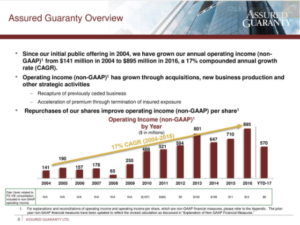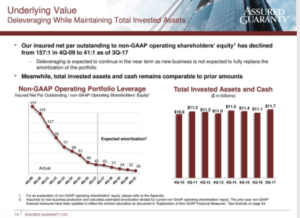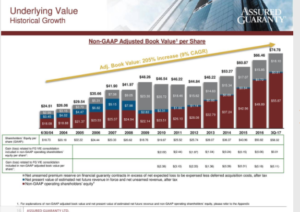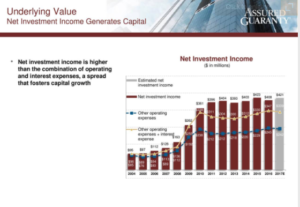Dear Investors,
The biggest mistake we can make as investors is focusing on the short-term and ignoring the long-term. Investing is by definition a long-term endeavor. A market participant may speculate that Tesla stock will go up in the next 3 months, but that doesn’t meet the definition of an investment, which necessitates rigorous fundamental analysis. Think back to just 18 months ago when the world was stunned by the Brexit vote. Banks and other financial institutions, which had already been hammered due to concerns about low interest rates and energy exposure, declined dramatically as market participants forecasted that this political event could prompt a negative economic shock globally. 18 months later, many of these banks, which we were hugely invested in have increased by 50-100%, and nearly every commentator on TV advocates buying them. As value investors, we have been harvesting profits on them.
We broke down the exposures of the banks to energy in our newsletters last year and showed that it was not very material whatsoever. We also highlighted that Brexit was much more of a political event than an economic event, although clearly Britain would deal with long-term economic impacts. If you look at today’s markets you see clear signs of euphoria. Bitcoin, stock markets, and bond markets, all reflect valuations that are some of the highest in history. The current excitement is rationalized based on excitement over tax reform and increasing signs of global economic growth. While I’m certainly optimistic about some of the economic signs we are seeing in Europe and the United States, it is difficult to ignore that by year-9 of a bull market, much of this optimism is priced in. Also, I’ve been worried about China for a long time and I still believe there are some skeleton in that closet.
We are around a decade away from the stock market peak reached in 2007 and I remember a conversation I had with a client. I expressed my concerns about the overall market, which had been rallying strongly, as the economy was considered to still be in a “goldilocks” period of good growth and low inflation. He said that stocks never crash from all-time highs and I thought to myself how little substance or financial analysis was behind that rationale, yet how persuasive recent market gains can be to investor psychology. I see similar logic being used today in that people that raise questions about current valuations are shouted down as being wrong in light of this year’s returns. What basis does one year’s returns have on predicting future returns? None and in reality it is contrary as the data shows how most market participants lose money due to short-term performance chasing, when the previous winner’s stocks have gotten expensive.
One of my favorite movies of all time is The Big Short, which is about the Financial Crisis. Christian Bale plays the role of hedge fund manager Michael Burry, who made an absolute fortune during the crisis by buying credit default swaps on subprime mortgage bonds. Credit default swaps are basically insurance policies on bonds, so Burry had to pay regular premiums, which ate away at investors capital. The movie showed months and even years go by where Burry’s investors were losing money, despite a buoyant stock market. Many of his investors and large financial backers thought he had lost it and left him, but as a value investor, Burry focused on the financial data. It was clear when he broke down the loans, cash flows, and credit, that this was a bubble that was going to burst. When it did, him and his patient investors made an absolute fortune!
I’m not saying the economy is anywhere near as at risk as it was in 2007, but a 20 or 30% loss in stock markets is a pretty horrible thing, and I do believe that the overall market is very susceptible. Even more concerning than short-term mark to market losses, is that if you are invested in an index, it is almost impossible to imagine generating even 5% returns per year over the next decade. The growth is not there, leverage is very high, and the only way it would be achieved is by multiple expansion from already record-high multiples. Hence, the current market euphoria based on strong short-term returns, is very likely to lead to immense disappointment and possibly even negative returns. I’m not a negative person so I want to reiterate that we have been bullish for 9 years, when many others were extremely pessimistic, as those of you have followed us have known.
So with this pessimistic backdrop, how do we avoid permanent losses of capital and actually make money? Most of our current investments are dedicated to special situations, where the short-term outlook shows little reason for optimism, but the long-term shows very low risk and high rewards. That doesn’t mean it will take a long time to make a lot of money as sentiments can change fast. A perfect example is our investment in Macy’s. This has been the year conventional retail has supposedly died as ecommerce at 12% market share, will take over forever, is the line of thinking. Macy’s has been making investments to improve its competitive position via ecommerce, off-priced additions to its stores such as Last Act, and investments in its rapidly growing salon-spa Blue Mercury. Inventories have been whittled down leading to increased margins, and the company is monetizing some of its lucrative real estate. On signs of a strong holiday season, the stock has rallied from $18 or $19, to $25-26, which is up roughly 40% from the lows. That is a big move and that doesn’t factor in the greater than 6% dividend yield the company pays. Mean reversion is one of the most powerful realities of markets and it is really where the big money is made. We don’t need Macy’s to be the next Amazon, we just need the future to not be as horrific as the market implies. 75% as bad would make us a lot of money!
Our largest investment Assured Guaranty (AGO), has the short-term negative concern of Puerto Rico. I’d encourage you to actually look at AGO’s financial statements to see the company’s book value and earnings growth over the last 5 years.
I’m not aware of any insurance company, that has done better. Despite this track record of success, the company trades at less than 50% of its adjusted book value of around $75, which is also been rapidly growing. The company is writing a lot of new business in a variety of different ways, which should be highly profitable. Also, being that the company is in the best condition in its industry, it has consolidation opportunities that it can exploit to create further value in excess of expectations. With all that said, how do you get positive news when Puerto Rico is mired in bankruptcy and dealing with the aftermath of two hurricanes?
The answer is it just takes time. Puerto Rico’s economy is going to get a massive stimulus from the Federal Government’s disaster recovery funds and insurance proceeds. In both Katrina and Superstorm Sandy, these proceeds exceeded the hurricane destruction. Structural reform must occur and is a focus of politicians and the Oversight Board. The bond insurance companies have an incredibly strong record of enforcing their legal rights and offering solutions that are beneficial both for the defaulted municipality and for recoveries, such as by providing access to credit. The bankruptcy process is frustrating because the creditors really have no enforceable rights until the fiscal plan and plans of adjustment are made, which are 100% negative for creditors as part of negotiating tactics. This is the type of short-term negativity needed to provide an incredible investment opportunity in an overvalued market. As time goes by and the situation works itself out, creditors will be able to enforce their rights, such as a perpetual lien on the revenues of the electric utility. As solutions are found and more clarity arrives for ultimate losses, the stock should rise dramatically! Usually, the stock moves before you really get that clarity, since the stock market is usually a forward-looking mechanism, so I’m not saying it will necessarily take 2-3 years to get the big returns, but it is virtually impossible to predict the timing.
Our results on investments like Assured Guaranty are not reliant on what the overall market will do. They are reliant on the future financial strength and earnings power of the company. This hurts us in a year like 2017, when just about everything seems like it is going up, but it helps us in more normal environments. This is how you make the big long-term money via investing and we have a track record of success in doing so.
Below is an interview where hugely successful investor Stanley Druckenmiller outlines the importance of long-term thinking while investing.
Thank you very much and as always please let me know if you need anything at all!
If You Invest In Conventional Wisdom You’re Going To Lose Your Butt
Sincerely,
Tim Travis




